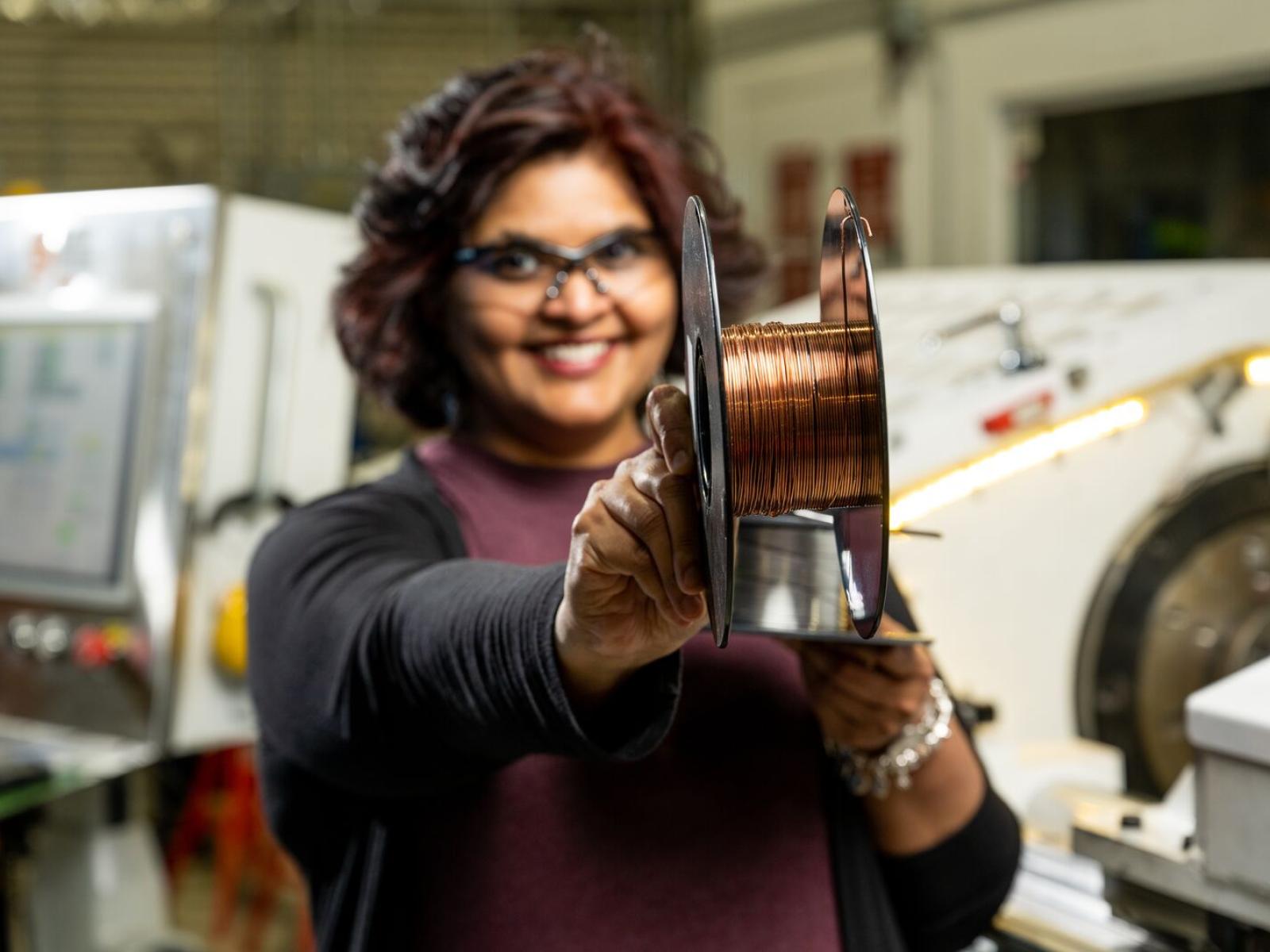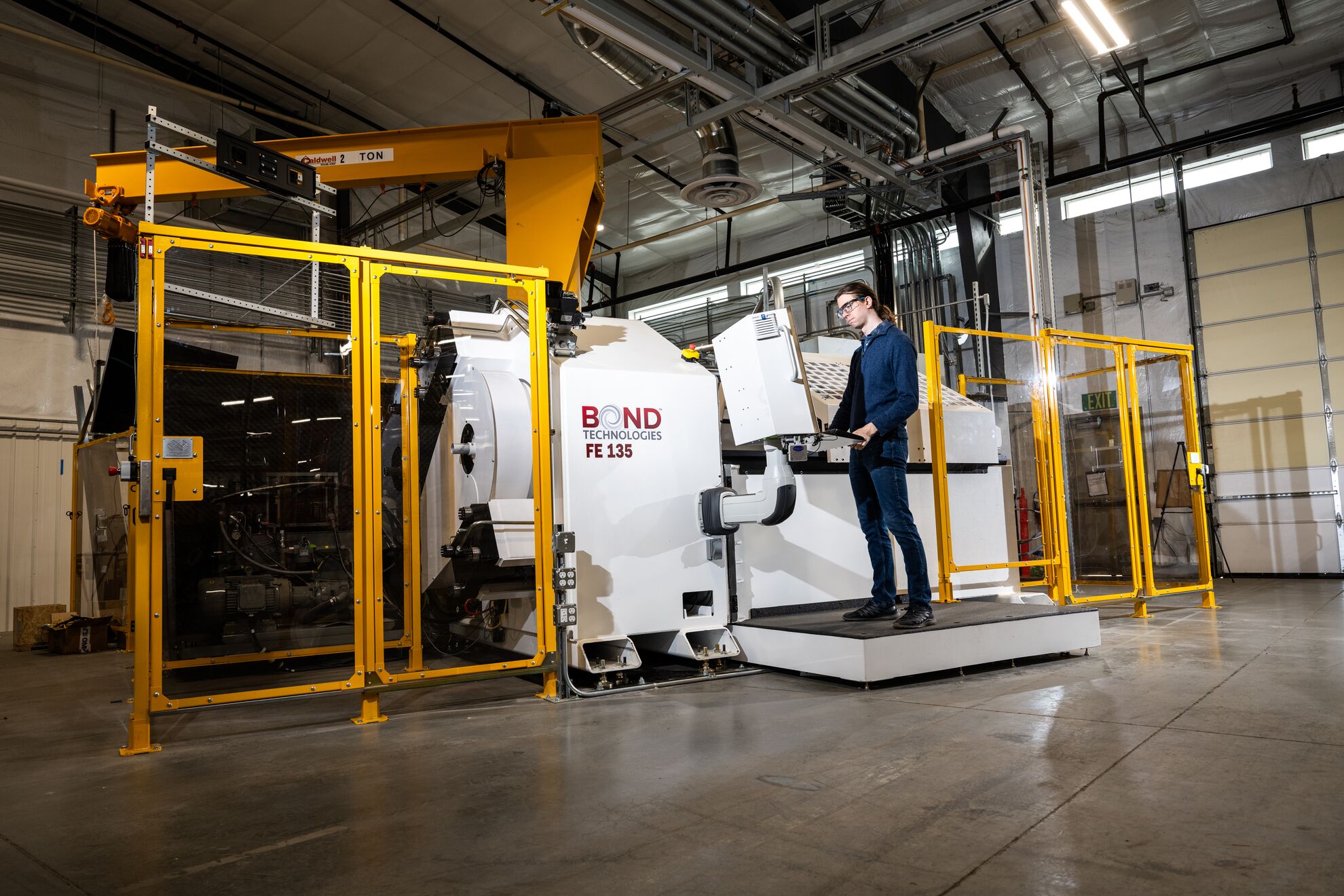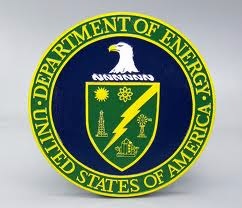From The DOE’s Pacific Northwest National Laboratory
6.24.24
Steven Ashby | PNNL

Keerti Kappagantula, a materials scientist at PNNL, is part of a team working to fabricate copper and aluminum wires that are more conductive than regular copper for use in the transportation industry.(Photo by Andrea Starr | Pacific Northwest National Laboratory)
Today’s manufacturing industry faces several challenges. Companies are looking for ways to increase efficiency, reduce costs, lower carbon emissions and improve their products—all while remaining competitive.
At the Department of Energy’s Pacific Northwest National Laboratory, researchers are developing and applying novel approaches to sustainable advanced manufacturing that may help companies overcome these hurdles and, in so doing, strengthen American economic competitiveness.
At the forefront is PNNL’s patented Shear Assisted Processing and Extrusion (ShAPE™) technique. Conventional extrusion typically involves heating feedstock materials that are then pushed through a die to form wires, bars or tubes. ShAPE™, on the other hand, eliminates the separate, energy-intensive step of heating of the material.
Instead, a hydraulic press pushes the material against a quickly rotating head that generates enough frictional heat to soften it. This unique process also deforms materials in a way that enables novel chemistries and microstructures that result in better properties.
For example, researchers demonstrated that ShAPE™ uses 50 percent less energy to manufacture a specific aluminum alloy often used in vehicle manufacturing. In addition to saving energy, ShAPE™ also extrudes aerospace aluminum ten times faster than standard methods and resulting components can stretch 50 percent further before breaking.

PNNL materials scientist Brian Milligan is among the PNNL researchers using the new Shear Assisted Processing and Extrusion™ machine in their research. Known as ShAPE 2, it is capable of extruded profiles 2 to 3 times larger than the first ShAPE machine and will be used to understand scaling of the ShAPE process. (Photo by Andrea Starr | Pacific Northwest National Laboratory)
Results like these have piqued the interest of commercial partners for a variety of applications. Atomic 13, a start-up manufacturing company, is scaling a ShAPE™ process that can convert post-consumer scrap aluminum into building components.
By eliminating the need to mine and refine virgin aluminum, this approach reduces the cost and 80 percent of the energy consumption and carbon dioxide emissions associated with those processes.
Given that the building and construction industry represents about 55 percent of the global aluminum extrusion market, ShAPE™ offers a promising step toward a circular aluminum scrap market, where “waste” becomes a resource for new materials and products.
In another trash-to-treasure success story, researchers at PNNL and a leading North American auto part manufacturer teamed to develop ShAPE™ so it could use recycled aluminum for vehicle components and other applications.
A new collaboration with Ford, Hydro, Padnos and the University of Michigan seeks to advance this process that converts scrap aluminum directly into new parts for electric vehicles.
Unlike today’s approach to recycling, which requires melting the scrap and adding fresh aluminum to “dilute” the impurities, ShAPE™ eliminates the impurities quickly and economically.
The parts produced with this new, more efficient process meet rigorous automotive industry performance standards while making it possible for automobile manufacturers to make next-generation vehicles greener and cheaper.
Researchers also are exploring the potential for ShAPE™ to increase the conductivity of copper alloys and composites beyond that of pure copper. In an emerging effort, they are simulating the possibility of producing ultra-conductive wires from primarily aluminum.
Aluminum is lighter, cheaper and more abundant than copper, which is commonly used in electrical wiring. However, aluminum is only about 60 percent as conductive as its heavier counterpart.
If researchers can use ShAPE™ to make aluminum composites that are nearly 80 percent as conductive as copper, they would be appealing for uses ranging from electricity transmission cables to electric vehicle wiring.
Looking toward even greater impact, PNNL recently installed a bigger, faster ShAPE™ machine that can extrude larger and more complex components than the first-generation machine.
This allows researchers to move beyond proof-of-concept approaches to industrial-scale manufacturing. Additional ShAPE™ machines to support development of other specialized materials for higher-efficiency energy systems also are in the works.
It is exciting to see the real-world applications for—and benefits of—sustainable advanced manufacturing innovations like ShAPE™. By delivering the science and technology to move these solutions forward, researchers at PNNL are literally shaping the future of manufacturing.
See the full article here.
Comments are invited and will be appreciated, especially if the reader finds any errors which I can correct.
five-ways-keep-your-child-safe-school-shootings
Please help promote STEM in your local schools.
The DOE’s Pacific Northwest National Laboratory (PNNL) is one of the United States Department of Energy National Laboratories, managed by the Department of Energy’s Office of Science. The main campus of the laboratory is in Richland, Washington.
PNNL scientists conduct basic and applied research and development to strengthen U.S. scientific foundations for fundamental research and innovation; prevent and counter acts of terrorism through applied research in information analysis, cyber security, and the nonproliferation of weapons of mass destruction; increase the U.S. energy capacity and reduce dependence on imported oil; and reduce the effects of human activity on the environment.
Facilities
PNNL houses several scientific user facilities and research facilities.
Scientific user facilities
The Environmental Molecular Sciences Laboratory (EMSL) is a U.S. Department of Energy national scientific user facility. EMSL provides researchers around the world with integrated capabilities in oxide and mineral interface chemistry, high-performance computing and computational chemistry software, mass spectrometry, high-field magnetic resonance, and subsurface flow and transport.
The Bioproducts, Sciences, and Engineering Laboratory (BSEL) is a joint effort between The Washington State University and PNNL, and is located on the WSU-Tri-Cities campus. Within BSEL, researchers are developing technology for converting agricultural byproducts into chemicals for products like plastics, solvents, fibers, pharmaceuticals, and fuel additives.
Researchers at PNNL’s Radiochemical Processing Laboratory are developing processes to advance the cleanup of radiological and hazardous wastes; the processing and disposal of nuclear fuels; and the production and delivery of medical isotopes.
The Applied Process Engineering Laboratory (APEL) is a technology business startup user facility, sponsored in part by PNNL. APEL provides engineering- and manufacturing-scale space and chemical, biological, and electronic laboratories and equipment for developing, validating, and commercializing new products.
Research facilities
Three research facilities were constructed on PNNL’s Richland, Washington campus to partially replace laboratory and office space PNNL had been using on the south end of the nearby Hanford Site.
The Physical Sciences Facility, a federally funded research complex that was designed by Flad Architects, opened in 2010 houses PNNL’s research into materials science, radiation detection, and ultra-trace analysis. The privately funded Computational Sciences Facility and Biological Sciences Facility house about 310 staff who support PNNL’s energy, environmental, national security, and fundamental science research missions. These two new facilities opened in 2009. The CSF contains scientific capabilities in information analytics, high-performance computing, cyber security and bioinformatics. The BSF focuses on bioenergy, environmental and soil remediation and includes systems biology, microbial and cellular biology and analytical interfacial chemistry.
The Electricity Infrastructure Operations Center at PNNL combines software, real-time power grid data and computation into a control room setting. The ideas and technologies developed in the EIOC address better management of the power grid. The EIOC also is available to utilities, vendors, government agencies and universities interested in research, development or training.
PNNL-Sequim (2022–present), previously known as the Marine and Coastal Research Laboratory (2021) and the Marine Sciences Laboratory (1966–2021), located at Sequim, Washington, is the DOE’s only marine laboratory. PNNL-Sequim provides analytical and general-purpose laboratories, as well as wet or support laboratories supplied with heated and cooled freshwater and seawater. More than 20 engineers and scientists work on coastal restoration and security projects, from reviving salmon habitat to research on how shellfish could detect a bioterrorist attack. PNNL-Sequim also operates a 28-foot (8.5 m) research vessel.
Other PNNL research facilities include the following:
Research Aircraft
Pretreatment Engineering Platform
Microproducts Breakthrough Institute
Joint Global Change Research Institute
Instrument Performance Testing
Hanford Meteorological Station
In Vivo Radioassay and Research Facility
Non-Destructive Analysis Laboratory
Radiological Calibration and Irradiation Facility
Proteomics other Mass Spectrometry-based Omics
Shallow underground laboratory for low-activity radiation measurement
The Laboratory has been operated by Ohio-based Battelle since 1965




